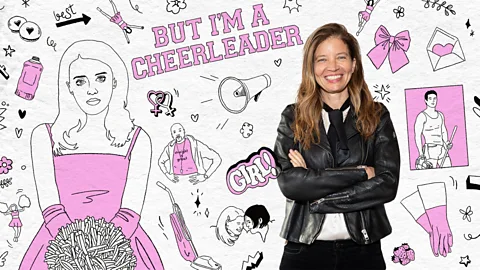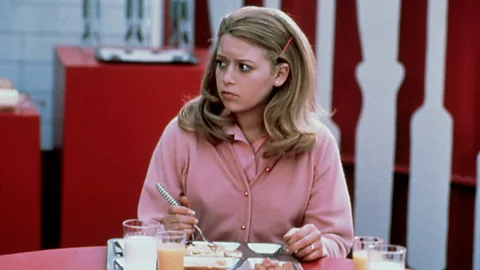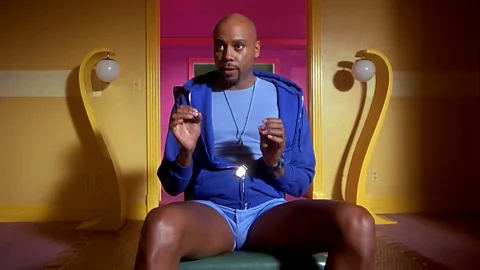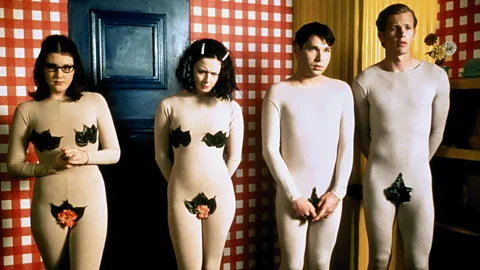 Emmanuel Lafont/Getty Images
Emmanuel Lafont/Getty ImagesThis 1999 unlikely romantic comedy set in a conversion therapy camp and starring Natasha Lyonne was panned by critics, but has since been hailed as groundbreaking and entertaining.
Jamie Babbitt’s bold feature debut, But I’m a Cheerleader, is a bona fide LGBTQ+ cult classic. The satirical romantic comedy premiered at the Toronto Film Festival 25 years ago in September 1999 and was initially panned by critics, but has since garnered well-deserved acclaim as a pioneering lesbian portrayal and otherwise. Babbitt’s film is a bombastic yet heartfelt shattering of gender stereotypes and the sordid practice of conversion therapy.
Indeed, with its wit, flair and refusal to bow to convention, the film was key to the widespread lesbian awakening that took place in Hollywood in the 1990s, a time when more well-rounded, relatable lesbian characters were slowly beginning to emerge. Babbitt says the concept for the film came from a desire to fill a void. “I was a young femme lesbian in my 20s and I hadn’t seen any lesbian films that felt cinematic to me,” she told the BBC. “I wanted to tell a story about a femme lesbian using the femme power of cheerleading to save a butch lesbian.”
 Alamy
Alamy“But I’m a Cheerleader” follows all-American teenager and pom-pom-wielding Megan Bloomfield, played by then-19-year-old Natasha Lyonne, who is bewildered when her conservative parents send her to a corrective conversion therapy camp called True Directions. She arrives, still with her pom-poms in hand, but the joke is that she ends up learning that her vegetarianism and admiration for singer-songwriter Melissa Etheridge indicate her latent lesbianism.
The film subverts the typical coming-of-age story of teenage characters going on a journey of emotional exploration, instead depicting Megan and her fellow gay teenagers as they undertake an eyebrow-raising five-step program to suppress their feelings and “overcome” their “homosexual tendencies.” But the attempt is apparently futile, and Megan ends up partnering with Graham (Clea DuVall), a feisty young woman and rebellious lesbian who sees through the glamorous and cheerful surface of the institution.
Lesbian Representation
At the time of the release of “But I’m a Cheerleader,” Fight Club and matrix was dominating the box office and same-sex marriage had not yet been legal in the U.S., queer films were tentatively entering the mainstream, but I’m a Cheerleader stood out among the many LGBTQ+ films of the time in one key way: it was unashamedly funny.
Culture changers
Culture Shifters is an interview series in which prominent creators reflect on the work that has had a major impact on the world. Read other articles in the series here.
“In the ’90s, a lot of my gay friends were dying of AIDS,” Babbitt says, explaining his decision to turn a serious subject into a lighthearted film. “Comedy was important, because if you don’t laugh, you’re going to cry.” The iconic queer films of the time that emerged from the epidemic were decidedly dark: Peter Jackson’s 1994 Heavenly Creatures, about two teenage girls who become murderers, Kimberly Peirce’s 1999 Boys Don’t Cry, about the brutal murder of transgender man Brandon Teena, and Lana and Lilly Wachowski’s 1997 thriller Bound, about a lesbian facing constant threats in the world of underground crime.
In contrast, Babbitt wanted to craft a story that uplifted the community in the wake of such grief, on and off screen. The light camp feel of But I’m Not Here perhaps led to a trend of more playful and triumphant queer films, such as Angela Robinson’s 2004 parodic lesbian romantic comedy DEBS, about the relationship between a trainee spy and her nemesis, and more recently Emma Seligman’s 2023 Bottoms, which follows a gay high school fight club. The conversion camp where the film is set is well suited to traumatic meditation, but But I’m Not Here is lighthearted and fun.
 Alamy
AlamyTake, for example, a scene in which the teenagers are tasked with identifying the “roots” of their homosexuality. Their self-diagnoses range from going to an all-girls boarding school to their mother marrying a trouser-wearing man, with each explanation more ridiculous than the last. The film gets even funnier when camp counselors Mary (played by Cathy Moriarty) and “ex-gay” Mike (played by RuPaul, a decade before RuPaul’s Drag Race) respectively teach the girls how to raise a baby and the boys how to chop firewood. Both scenes are full of unintentional sexual innuendo.
“I was always drawn to comedy, but I wasn’t interested in the shock and gore of John Waters. I wanted a bittersweet romance fairy tale with some poignancy,” Babbitt says. But I’m a Cheerleader celebrates the friendship of a group of teens who reflect the different sides of lesbianism, and it also focuses on the development of Megan and Graham’s love story. The story unfolds awkwardly, but importantly, there’s no fear for either. In the darkness, Babbitt finds hope. She says she wanted to reflect the irony that a conversion camp “can be a conduit for gay people in a small town to meet and fall in love.” I was trying to be optimistic about a very messed up situation.
Conversion therapy
What makes “The Good, the Bad and the Ugly” stand out among LGBTQ+ films of the ’90s isn’t just its prominent and heartwarming portrayal of lesbians, but also its scathing critique of conversion therapy, which seeks to change an individual’s sexual orientation or gender identity. The 2022 report states: The Trevor Project It’s estimated that 508,892 LGBTQ+ youth in the United States are at risk of undergoing conversion therapy in 2021. While recent films like 2018’s The Miseducation of Cameron Post and Teen Eraser have taken a somber look at conversion therapy and depicted the violent consequences of such practices, decades ago, film My Love broke boundaries by approaching the subject through satire.
Among other things, the film explores how conversion therapy is based on reinforcing outdated gender stereotypes: in True Directions, “They say if you like pink and Barbies you’re ladylike, and if you wash dishes and clean and cook you’re straight,” Babbitt explains. “I wanted to show how unnatural that is.”
This artificiality is reflected in But I’m a Cheerleader’s overall aesthetic, including the campy costumes and art. In True Directions, the teens wear polyester gender-neutral uniforms, and the Technicolor artificiality extends to the girls’ bedrooms, with their kitschy plastic pink sheets. As Babbitt says, she wanted camp to look like “a Barbie Dreamhouse because it’s so plastic, so fake, so unorganic.”
 Alamy
AlamyThe film culminates in the teenagers’ final exam before graduating as “straight”: mock heterosexual sex. Those who make it must wear fully nude leotards with Adam and Eve-style leaves and flowers on their genitals. They must pair up with a member of the opposite sex and lie down together in a fabricated reality of heterosexual sex to practice thrusting.
Cult status
Ultimately, Babbitt says, achieving her biggest filmmaking goal – making a gay Clueless – was harder than she initially thought. “My agents and managers were telling me, [actors] “I had a hard time getting actors to star in my films because I wanted to stay in the closet,” Babbitt recalled. “Clea DuVall was nervous, her manager was nervous, and by the way, [lots of the cast and crew] “She was gay and her manager was gay.” Against this backdrop, Babbitt’s boldly written queer story seems all the more brave.
But “I’m a Cheerleader” wasn’t always such a cult favorite. Though it seems tame today, director Babbitt’s film originally received the highest NC-17 rating, deemed commercially harmful, for scenes featuring lesbian oral sex and implied masturbation, which had to be cut to bring it down to an R rating. “That was stupid,” says Babbitt. [and] “This is offensive,” Babbitt said of the requested edit changes. “It was rated R, but when you watch it now it’s literally rated PG.”
When the film premiered, Babbitt was scorned by critics. “I went to Sundance and was shocked to see it was panned,” she recalls. “Variety gave it a scathing review, Entertainment Weekly gave it an F. I still haven’t seen the movie. [another] “It got an F from Entertainment Weekly, but I’m 50!” Furthermore, made on a budget of $1 million, the film made little impact at the box office, grossing just $60,000 during its opening weekend.
Jamie Babbitt’s Five Cultural Transfigurations
Amy Heckerling – Clueless (1995). Amy imbued these inspiring stories of teenage joys and terrors with nuance and emotion, and her unpretentious, hilarious work, with a magical feminine touch, has forever marked the teen film genre.
Nicole Eisenman – Paintings (Other)Nicole rose to prominence in the art world of the 1990s. Her figurative paintings of queer women and their overt comedy and sexuality highlighted a new wave of queer people who were no longer hiding their same-sex attraction or sexuality and were finally coming out of the closet.
Bikini Kill – Rebel Girl (1993)Kathleen Hanna’s band shook the punk world out of its misogyny. Their music was full of female anthems celebrating friendship and empowerment, like this one, and their lo-fi sound inspired countless teenage girls to pick up an instrument and start playing their truth.
Adrienne Rich – Collected Poems (1950-2012)Soulful, textured poetry about the inner life of lesbians. Both direct in its language and layered in emotion. Masterful use of language at the highest level.
Jane Campion – The Piano (1993)Every film Jane makes, from the short film Peele to this blockbuster hit, is entertaining, complex and highly original. She is a true master of the complex, dark and funny ways in which humans exist in this world.
But while most films that receive this kind of initial response then disappear forever into cinema archives, But I’m a Cheerleader has achieved cult status and remains at the top of lists of LGBTQ+ film recommendations to this day. “I knew the movie resonated with my peers because young girls were approaching me all the time,” Babbitt says.
The film’s legacy lives on throughout pop culture. Silk Chiffon The music video pays homage to the cheerleader footage in the film The Miseducation of Cameron Post, mimicking the final scene of “But I’m a Cheerleader,” in which the teenagers are loaded into the back of a truck and whisked away to brighter futures. [But I’m A Cheerleader] “It feels like our art reflects each other,” Babbitt says.
Beyond these specific references, But I’m a Cheerleader continues to resonate with its self-reflective comedy, camp aesthetic, and decidedly optimistic outlook. The film brought laughter to a dark time in LGBTQ+ cinema, and now it’s resonating with an entirely new generation. “I’m not that surprised now that this film still resonates with people, because when I made it, this film spoke to me. I just didn’t think it could get any better than this,” says Babbitt.
Source: BBC Culture – www.bbc.com





